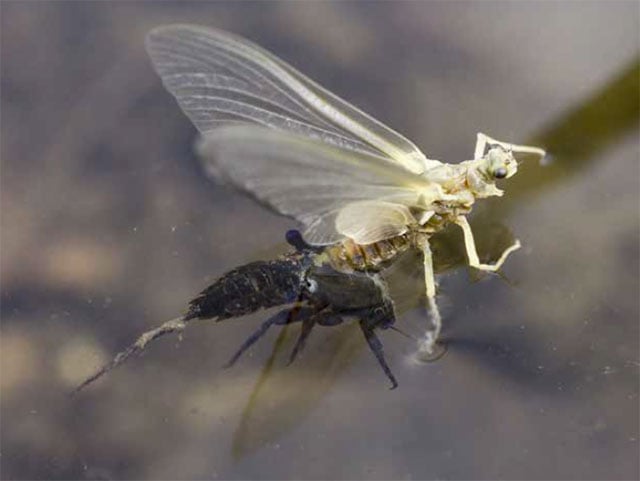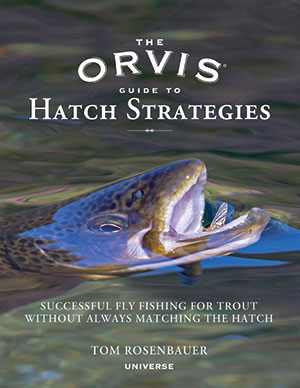Why an Emerger Is Almost Always a Better Bet Than an Adult

This is the stage of mayfly hatches that trout prefer—when the emerging dun gets stuck trying to escape the nymph shuck. You can also see why dry flies with trailing shucks work so well, and why I tie my shucks in brown instead of the more traditional light tan.
The secret to successfully fishing an insect hatch often boils down to simply fishing an emerger pattern as opposed to a typical dry-fly imitation of an insect with fully formed wings. You’ll often get splashy refusals to your standard dry flies. It may seem like you are not imitating the right insect, but often it’s just that you have not chosen the right stage of the insect. It’s natural—you see flies in the air and fluttering on the surface and you see trout rising. But by watching carefully you’ll see fish rising to seemingly invisible objects, because from 30 feet away it’s nearly impossible to see emergers in the surface film.
Why trout prefer the emerger stage is simple when you realize how they select their food. It has to be something familiar, something they recognize as food and have developed a search image for. Studies of trout in controlled laboratory conditions have shown that trout prefer the largest prey they recognize as food. But behavioral studies of trout in laboratories cannot even come close to the number of variables in a real trout stream, and those studies were performed on food dropped into the water, not emerging below the surface. Plus, the studies were performed with only a few food items that could be easily obtained, like mealworms and caterpillars. A trout in a natural trout stream might have a half-dozen possible prey items to choose from.
My theory, one that seems to hold up based on my observation of feeding trout for many decades, is that trout choose their prey based on how easy it is to capture. A common conundrum is when trout ignore large, meaty mayflies like the size 8 Eastern Green Drake and instead concentrate on the much smaller size 16 Sulphur mayflies that hatch at the same time. The common reasoning is that there are more of the smaller mayflies so the trout recognize them easier. But while Green Drakes bolt from the surface quickly, Sulphurs struggle with their shucks for yards on the surface before taking off. The smaller flies are more vulnerable, and trout realize the likelihood of them flying away is not as great.

Buy “The Orvis Guide to Hatch Strategies” in the MidCurrent Store
I saw a graphic example of this one day on the Henry’s Fork in Idaho. The weather had been bright and sunny and few fish were rising. Bob Gotshall and I decided to walk the river until we found some rising fish. We started at the Ranch Buildings area and walked up to Stock Bridge without seeing a single rise. We poked around in the big pool above the bridge, but didn’t see any fish feeding until a thunderstorm rolled in across the Tetons and the weather suddenly changed from Mozart to Shostakovich. Under the brooding skies, both Green Drake and Brown Drake mayflies suddenly began hatching and soon covered the surface. I watched a half-dozen fish feeding and noticed they crushed the Green Drakes but ignored the Brown Drakes. Both are large mayflies, but the Green Drake is a bit smaller so you would think the fish would have preferred the larger Brown Drakes. Both were on the water in about equal quantities. But when I got my face down to the water and watched a few mayflies emerge, I noticed that the Brown Drakes quickly shed their shucks while the Green Drakes had a lot harder time shaking loose, and the brown nymph shuck often clung to the emerging flies, preventing them from escaping the water. The trout knew this and were concentrating on the easier prey.
Another reason I suspect emergers are favored by trout is that they can see them from farther away. When a mayfly or caddis fly is fully emerged, it rides lightly on the water on its tiptoes and makes a faint impression in the surface film. But an emerger hanging just below the film is backed up against the mirror that surrounds a trout’s window and shows up starkly against that glowing mirror. In fact, I’ve seen instances where my imitation gets taken more readily than the naturals during a hatch, and I think it’s because even our highest-riding dry flies penetrate the surface film more than the real thing and are thus noticed more quickly.
Before you grab your fly box to throw away all of your standard dry flies, rest assured that there are times when you do want an imitation of a fully emerged adult fly. When trout seem to prefer flies that twitch or hop on the water, as they sometimes do with bigger mayflies or caddis flies, traditional winged dry flies work well. Another time is when you fish lower down in a pool where most of the flies emerge further upstream in the riffle. The fish lower in a pool see fewer emergers, thus they may have developed a search image for fully emerged flies riding the water.
Even more convincing is that most of the imitations we use when we think we’re imitating a fully emerged insect probably look more like an emerger to trout. Fully hatched flies ride up on their tiptoes. Their bodies hardly touch the water. Yet most of the dry flies we use float lower anyway, bodies and tails hanging in the surface film, because we have a hook attached to the flies and they’re just too heavy to float like an emerged insect. For instance, after the small yellow-colored mayfly we call the Pale Evening Dun gets rid of its shuck, it barely touches the surface. Its legs hold it above the film, and its body curls upright and doesn’t touch the water. So when we fish an upright-winged fly like a Comparadun, we think we’re imitating the adult, but the Comparadun fly suspends its whole body in the surface film and its tails lie flat in the film rather than curving into the sky like the real thing. So we’re imitating a different stage of the insect despite our best efforts! But it’s the better stage to imitate.
The flies we use also do a great job of imitating another stage of aquatic insects we don’t think about as often. We think of hatching bugs as if they were in a binary state—either emerging or fully emerged. But that is not how nature works. When insects hatch, some of them never fully emerge from their shucks and they struggle until they die of exhaustion and sink. Some people call these “cripples” and feel they deserve a separate imitation. But to me, a cripple is just an emerger that stays an emerger and never becomes an adult. I don’t think trout make a distinction either. You’ll see flies labeled as cripples and many of them are extremely effective patterns. But I don’t think they’re deadly because they imitate a cripple. The patterns just happen to be great emerger imitations.

ABOVE, LEFT: This is the way we envision mayfly duns on the water, riding on tiptoes with upright wings. ABOVE, RIGHT: This is how many mayfly duns end up—knocked over and bunged up. Trout still accept them eagerly, which is a reason your imitations don’t have to be perfectly balanced.
One further stage we don’t often think about is the “knockdown” stage of an emerging fly. This is a fly that has fully emerged as a winged adult, but got knocked over by the current or wind or a raindrop. Once aquatic insects’ wings touch the water, they have great difficulty righting themselves. They float for the rest of their short lives, and then, like cripples, they sink and drown. Many times your fly does not land perfectly upright on the water, and the wings or hackle on some flies create the impression of a knockdown—and this may be a good thing. Both knockdowns and cripples fall into that easy-to-capture category and are probably preferred by trout over an insect about to fly away, with its perfectly upright wings. This is one reason I don’t place a lot of emphasis on exactly the right fly pattern. In a hatch, fish may see a combination of fully emerged adults, emergers, cripples, and knockdowns. Those stages include a wide variety of profiles, colors, and attitudes of the flies in relation to the surface film.
Excerpted with permission from The Orvis Guide to Hatch Strategies: Successful Fly Fishing for Trout Without Always Matching the Hatch (Rizzoli, May 2017), all rights reserved.










